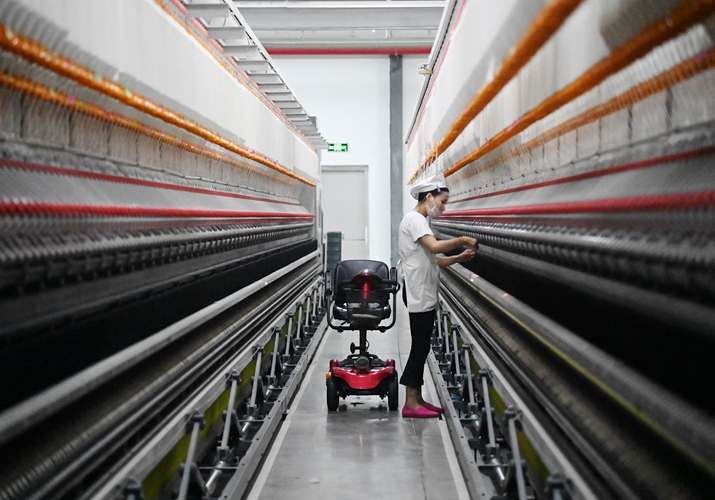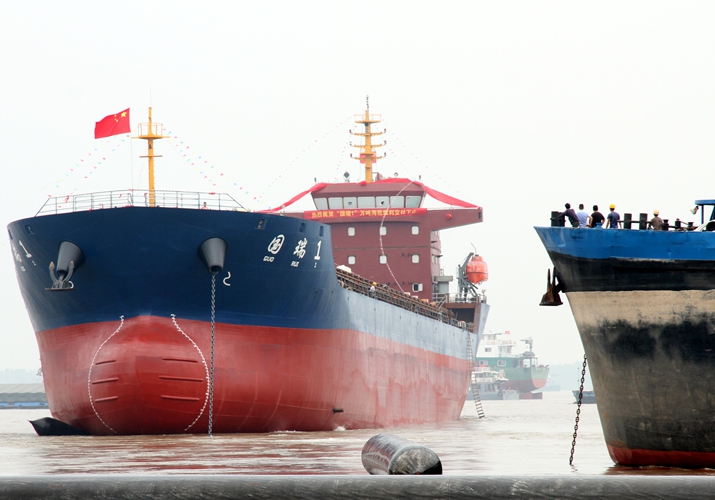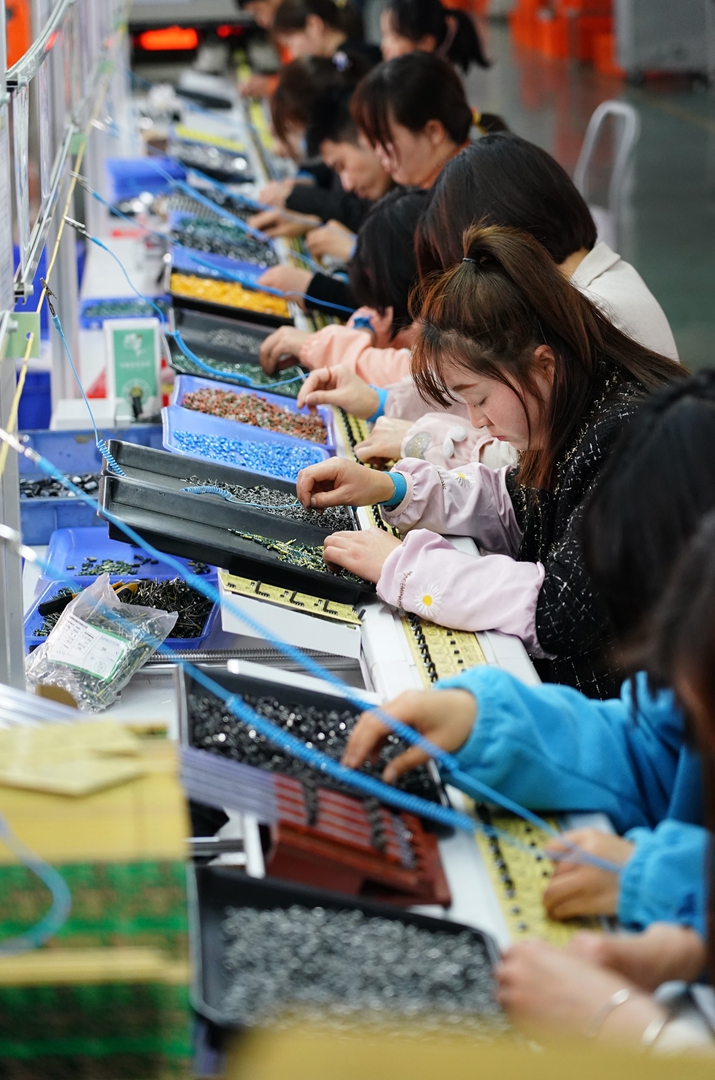
An employee works in a textile plant in Xiayi, Henan Province in central China, on September 26, 2020 (XINHUA)
It has been five years since Chen Yanan, an equipment engineer, returned to his hometown in Zhengzhou, capital city of Henan Province in central China, to work for a smartphone manufacturer in the city. Before that, he had worked in Shenzhen, Guangdong Province in south China, for six years.
"I came back because many factories here needed technicians, and the pay was no less than that in Shenzhen," he said. "Besides, I feel more comfortable working in my hometown."
His experience is shared by many of his current colleagues. After years of studying and working in the coastal cities, they found similar jobs became available in their hometown as more and more companies moved or expanded inland.
Industrial transfer is part of a strategy to promote coordinated regional development in China. The strategy includes advancing development in the western region, the northeast, the central region, the Beijing-Tianjin-Hebei region, the Yangtze Economic Belt, the Yangtze River Delta and the Guangdong-Hong Kong-Macao Greater Bay Area. The aim is to make regional development become more balanced. In the past years, China has made steady progress in implementing this strategy, contributing to its stable and sound economic growth and high-quality development.
A ship rolls off production line in Wuhu, Anhui Province in east China, on July 2, 2020 (CNS PHOTO)
New growth engine
Coordinated regional development is a crucial step to tap into the development potential and foster growth drivers. Henan was among the first provinces to implement the development plan by massively introducing industries from coastal areas. In 2010, its introduction of Foxconn, one of the world's leading electronics manufacturers whose investment in the Chinese mainland was previously concentrated in the coastal regions, brought it to the center of national attention.
The province was in a good position to get the deal when the company was seeking to move part of its production capacity inland. It had rich human resources as one of China's most populous provinces and robust infrastructure, especially transportation. Yet, it had to compete to get it.
A series of preferential policies were offered to Foxconn, which included turning an airport zone into an integrated free trade zone, the first of its kind in the central region. The deal was concluded in the same year. This allowed for tax benefits for the phones produced for exporting by air.
It didn't take long for the deal to pay off. The company's first plant located in the airport zone in Zhengzhou employed 130,000 people by the end of the following year. In 2012, the plant finished building 95 production lines and achieved sales of 20 billion dollars, becoming the world's biggest smartphone production base.
Foxconn then continued to build another two plants in the city and more plants in five other cities of the province. The company employs around 400,000 people in the province in total.
Over the past five years, the province has introduced over 3,400 projects worth over 100 million yuan ($15.4 million), and attracted investment of over 1 trillion yuan ($154 billion) from outside the province.
"Industrial transfer has been the main engine for Henan's industrial growth," said Yang Xinsheng, Deputy Director of the Henan Provincial Department of Industry and Information Technology, at a press conference on September 29, 2020.
By January this year, the province has developed two trillion-yuan-level industrial clusters, namely equipment manufacturing and food, and 19 other major industrial clusters, with 44 companies earning revenues of over 10 billion yuan ($1.54 billion), according to the department.
With more jobs created by these industries, the province, which is one of the most populated and an important source of migrant labor, is seeing a drop in the number of people who go outside the province to make a living. According to the province's reports on population development, the net outflow of population grew by 70,000 people in 2018, 310,000 less than the previous year.
National support
To promote cross-regional industrial transfer, the State Council published guidelines for the central and western regions to receive transferred industries in 2010. The guidelines specified the principles, key tasks and policy support for industrial transfer.
The guidelines emphasized that transfers should be market-oriented, transferred industries should be concentrated in key areas, and backward industries with heavy pollution or outdated production capacities should be excluded. It also suggested that each region should focus on sectors where they enjoy advantages over other regions to avoid redundant development of any industry.
To further facilitate proper deployment of industries in different regions, a detailed catalogue of industries recommended and discouraged for each region was published by the Ministry of Industry and Information Technology in 2012 and updated in 2018 to include emerging industries.
In 2010, the country approved its first demonstration areas for industrial transfer in Anhui Province, which involved Hefei, Wuhu and another eight cities. Special support was given to the demonstration areas in a bid to form large-scale industrial clusters. After that, more national or provisional demonstration areas were set up.
On October 15, 2020, the China (Zhengzhou) Series of Industrial Transfer Docking Activities was held for the sixth time in Zhengzhou. The event serves as a platform for transferring industrial projects from better developed areas of China and abroad. Since its first launch in 2010, the national event jointly held by the Ministry of Industry and Information Technology and several provincial governments has facilitated the signing of 2,975 projects worth 1.39 trillion yuan ($214 billion).
The 2020 event has seen the transfer of 778 projects through the platform, 76 percent of which were from Beijing-Tianjin-Hebei region, the Greater Bay Area and the Yangtze River Delta region, three growth poles in the country.
Notably, the transferred projects were not limited to traditional industries, but included a fair proportion of emerging industries such as new-generation information technology, high-end equipment manufacturing and new-energy automobiles.
Locals work in an electronics plant in Ankang, Shaanxi Province in northwest China, on March 15 (XINHUA)
Ongoing exploration
On March 11, the outline of the 14th Five-Year Plan (2021-25) for national economic and social development and the long-range objectives through the year 2035 was approved during the annual Two Sessions - annual sessions of the National People's Congress (NPC) and the National Committee of the Chinese's People's Political Consultative Conference (CPPCC). Coordinated regional development was an important part of the plan and a topic of concern for NPC deputies and CPPCC members.
The past five years have seen notable growth in the western and central regions. They registered an annual GDP growth of 7.3 and 6.7 percent respectively, above the 6.1 percent national average. However, the growth in the northeast region has been sluggish, with the rate of 4.5 percent in 2019. New breakthroughs need to be made to revitalize the region, as stated by the five-year plan.
Other concerns include insufficient docking platforms and imperfect procedures for conducting industrial transfer. Improving public services and business environment in receiving regions is also considered an important task for better transfer.
In the eyes of Qian Xueming, a member of the National Committee of CPPCC and Vice Chairman of the Provincial Committee of the CPPCC of Guangxi Zhuang Autonomous Region in south China, inter-governmental cooperation needs to be improved for better cross-regional industrial transfer.
The autonomous region as a whole was lifted out of poverty last year, but many people relocated from poor villages to urban areas have to leave to find work in eastern coastal regions, because local industries cannot provide enough jobs.
In an interview with Southern Metropolis Daily, Qian said a major problem in the efforts to introduce more industries to the western region is the reluctance of the local government of the area where the industries are originally located.
"In such transfers, while western regions get new industries and companies enjoy lower costs, the governments in the coastal area get nothing," he said. As a result, local governments in the western region often negotiate transfers directly with companies without the involvement of the government of the place where the companies were first stationed.
"It seems as if we are stealing from other regions, and the efficiency is low without the full support of the local government," he said.
He mentioned a case where he tried to move some wood processing companies from Guangdong Province to Guangxi in 2018. These companies purchase timber from Guangxi and export after processing. Moving to Guangxi meant cutting freight charges and the products could be exported directly from Guangxi's ports. The deal failed because the local government in Guangdong didn't support it.
Qian's solution, as he included in his proposal to the National Committee of the CPPCC during this year's Two Sessions in March, is a top-level design to encourage local governments in the developed regions to move their old industries to the west by, for example, including such transfers as an indicator of local government performance evaluation.
"It will be much easier to transfer industries to the west if governments in the developed regions are ready to do so," Qian said.
(Print Edition Title: Shared Growth)
Comments to hufan@chinafrica.cn


